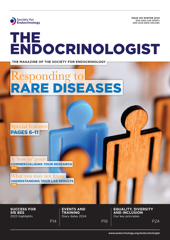Paul Stewart is Emeritus Professor of Medicine at the University of Leeds. Until his recent retirement, Professor Stewart was a Consultant Endocrinologist at the Leeds Teaching Hospitals NHS Trust, with particular interest in endocrine hypertension, disorders of the pituitary–adrenal axis and reproductive endocrinology, although he was still also actively involved in acute medical admissions until six years before he retired.
The work of his research group spanned discovery science, early translation and patient-related outcomes, with a main focus on cortisol and its metabolism by the 11β-hydroxysteroid dehydrogenases (11β-HSDs), Cushing’s syndrome and pituitary tumours.
Professor Stewart is also Editor-in-Chief of Journal of Clinical Endocrinology & Metabolism. Here, he tells us about his career and the source of his inspiration.
How did your career lead you to research into 11β-HSD/cortisol metabolism?
This can, in many ways, be summarised as ‘serendipity’. After graduating from medical school in Edinburgh, I was destined for a clinical training rotation in cardiology. However, as a senior house officer in endocrinology/diabetes working for Chris Edwards, I became involved in the elucidation of a patient with a rare form of inherited hypertension: the syndrome of apparent mineralocorticoid excess (AME).
We went on to demonstrate that the offending mineralocorticoid was the ‘glucocorticoid’ hormone cortisol, and successfully treated the patient with suppressive doses of dexamethasone. We identified the enzyme responsible for the inactivation of cortisol to cortisone in the kidney (11β-HSD), showed how liquorice ingestion inhibited this pathway, replicating a milder form of AME, and identified mutations in the gene encoding 11β-HSD2.
This was a hugely exciting phase of my career – Chris was an amazing supervisor and remains a close friend.
What has kept you interested over the years you have worked in this area?
Perhaps not surprisingly, after my first four or five papers were published in Journal of Clinical Investigation or The Lancet, I was hooked on research and fascinated by the impact it could have on my patients.
AME became a paradigm for an emerging concept in endocrinology – ‘intracrinology’ – mediated by the pre-receptor metabolism of hormones in peripheral tissues. Thus, in all of us, 11β-HSD2 protects the mineralocorticoid receptor in our kidneys from cortisol excess and permits aldosterone to bind. The opposite-acting enzyme, 11β-HSD1, augments glucocorticoid action in key tissues such as liver, adipose, bone, muscle and skin, by activating cortisol from inactive cortisone. In 2011, it became one of the most patented biomedical targets worldwide, as numerous pharmaceutical companies embarked on selective 11β-HSD1 inhibitor programmes. The opportunity to work closely with industry/drug discovery pathways was enlightening.
'Perhaps not surprisingly, after my first four or five papers were published in Journal of Clinical Investigation or The Lancet, I was hooked on research.'
Above all though, the main interest came from the people involved. I have had the pleasure to train 40 PhD/MD students in my career. To see their enthusiasm, their influence on our team’s scientific approach and their onward personal career development has been immensely gratifying. They are still my extended family!
How have the clinical and research sides of your career intersected?
This was absolutely critical. Working in large tertiary referral centres meant there was no shortage of clinical material and living examples of the wonderful but also devastating effects that hormones can have on patients. Cushing’s syndrome remains a fascinating disease and, on a daily basis, I was drawing on my clinical experience to inform and refine our research priorities and approach.
I had the good fortune to meet the Nobel Laureate and geneticist/biologist Sydney Brenner on a couple of occasions, and was always taken with his advice that ‘the best (animal) model for human disease is man’. Thanks to my training, I was privileged to be able to move from bench to bedside and back again, largely using clinical material as my disease models.
How have technological advances (e.g. the omics explosion) shaped your research?
They have had a very significant impact. The rationale for my move from Edinburgh to Birmingham in 1989 was to be trained in molecular biology. Michael Sheppard, Jayne Franklyn and Kevin Docherty in Birmingham were at the forefront of what was then a new technology, and embellishing this into my research was essential. This was endorsed through a further period of training with Ian Mason and Evan Simpson at UT Southwestern Medical Center in Dallas, TX, USA (funded as an MRC Senior Clinical Fellow).
Cedric Shackleton, based in Oakland, CA, USA, is the gas chromatography/mass spectrometry (GC/MS) guru when it comes to steroid hormones. We became close friends following our AME/liquorice work in the early 1980s. Through Wellcome Trust and European Research Council programmes, I was able to fund him to join the group in Birmingham and establish a GC/MS facility that could profile around 40 urinary corticosteroid metabolites, giving a direct read-out on individual cortisol metabolomes. This technology underpinned the clinical development of 11β-HSD1 inhibitors.
In addition, work with, and now led by, Wiebke Arlt has helped uncover new variants of congenital adrenal hyperplasia and alternative pathways for androgen secretion in the adrenal gland. It is leading to a novel diagnostic tool for patients with adrenocortical cancer. Omics certainly isn’t just about genes and proteins!
'On a daily basis, I was drawing on my clinical experience to inform and refine our research priorities and approach.'
What have been your career highlights?
As above – the people I have worked with, and witnessing the impact that research has had on the care of my patients and others.
What paper in endocrinology has most inspired you?
There are so many – be they Harvey Cushing’s original description of Cushing’s disease in the 1930s to Hench, Kendall and Reichstein’s marvellous description of the potent anti-inflammatory effects of cortisone in patients with rheumatoid arthritis in 1950. (Thanks to hepatic 11β-HSD1 expression, this resulted in the award of the Nobel Prize.)
However, my choice is as follows. I recall seeing a family with this rare hypertensive disorder in my clinic in Birmingham the week this was published. It is such a fascinating story and intricate unravelling of what was the very first monogenic example (AME being the second!):
Lifton RP, Dluhy RG, Powers M, Rich GM, Cook S, Ulick S & Lalouel JM 1992 A chimaeric 11β-hydroxylase/aldosterone synthase gene causes glucocorticoid-remediable aldosteronism and human hypertension Nature 355 262–265.
What do you consider your top three publications (impact factor/citation index aside)?
Publication 1: Stewart PM, Corrie JET, Shackleton CHL & Edwards CRW 1988 The syndrome of apparent mineralocorticoid excess: a defect in the cortisol–cortisone shuttle Journal of Clinical Investigation 82 340–349.
n=1 but what a prismatic case!
Publication 2: Bujalska I, Kumar S & Stewart PM 1997 Does central obesity reflect ‘Cushing’s disease of the omentum’? Lancet 349 1210–1213.
The spark that ignited 11β-HSD1 as a potential therapeutic target for obesity–diabetes–metabolic syndrome.
Publication 3: Tiganescu A, Tahrani AA, Morgan SA, Otranto M, Desmoulière A, Abrahams L, Hassan-Smith Z, Walker EA, Rabbitt EH, Cooper MS, Amrein K, Lavery GG & Stewart PM 2013 11β-hydroxysteroid dehydrogenase blockade prevents age-induced skin structure and function defects Journal of Clinical Investigation 123 3051–3060.
With 11β-HSD1 inhibitors effective in metabolic syndrome – but not at a magnitude to drive larger phase III studies – the focus became looking for orphan indications, once more informed from patients with untreated and treated Cushing’s syndrome. This a great example of how selective 11β-HSD1 inhibitors improve wound healing, work that is now led by Ana Tiganescu as an independent researcher.
How important have the environment and community been in shaping your research?
The quality of supervisors and other colleagues has been of the utmost importance, as discussed above. Mentorship is another important aspect; it is good to seek out mentors (ideally not your supervisor). More widely, I have benefited from my networking across UK (a big shout out for the Society for Endocrinology), Europe (I was a founding member of the European Network for the Study of Adrenal Tumors in 2002), the USA (another big shout out, this time for the Endocrine Society) and the International Society of Endocrinology. This has enabled me to meet some excellent researchers and clinicians, many of whom are now close colleagues. Endocrinologists are really nice people!
What advice would you give endocrine trainees who are embarking on their careers?
Be inspired, this is an amazing discipline of medicine, where you can make a difference.






